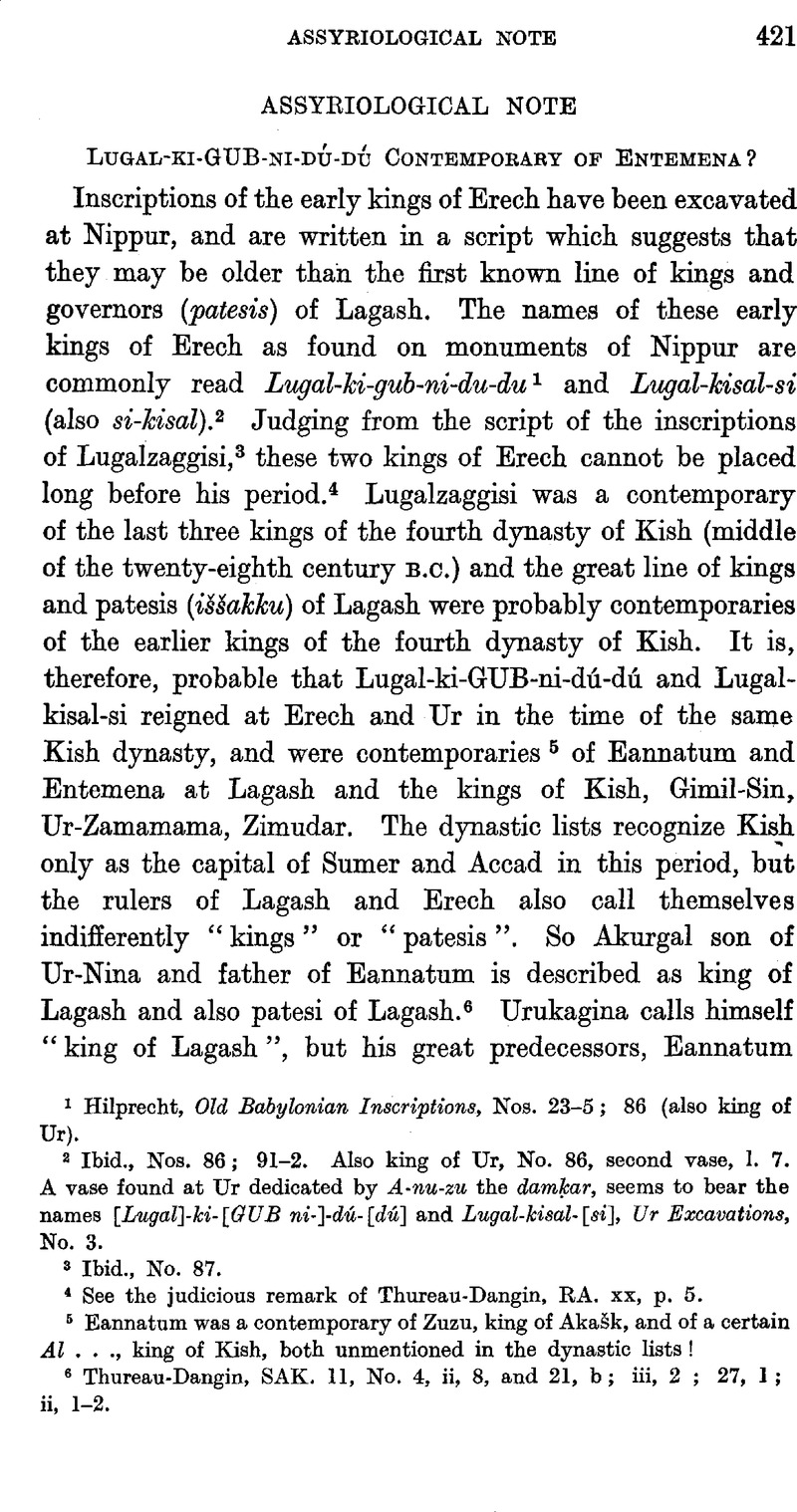No CrossRef data available.
Article contents
Abstract

- Type
- Miscellaneous Communications
- Information
- Copyright
- Copyright © The Royal Asiatic Society 1931
References
page 421 note 1 Hilprecht, Old Babylonian Inscriptions, Nos. 23–5; 86 (also king of Ur).
page 421 note 2 Ibid., Nos. 86; 91–2. Also king of Ur, No. 86, second vase, 1. 7. A vase found at Ur dedicated by A-nu-zu the damḳar, seems to bear the names [Lugal]-ki-[GUB ni-]-dú-[dú] and Lugal-kisal-[si], Ur Excavations, No. 3.
page 421 note 3 Ibid., No. 87.
page 421 note 4 See the judicious remark of Thureau-Dangin, RA. xx, p. 5.
page 421 note 5 Eannatum was a contemporary of Zuzu, king of Akašk, and of a certain Al …, king of Kish, both unmentioned in the dynastic lists !
page 421 note 6 Thureau-Dangin, SAK. 11, No. 4, ii, 8, and 21, b; iii, 2; 27, 1; ii, 1–2.
page 422 note 1 RTC. 48, Rev. iii, but 20, Rev. ii, lugal, “king.”
page 422 note 2 nam-šeš. The sign ![]() with values š;eš, “brother,” and uru, “to protect,” are different signs in the ancient script. SEŠ, REC. 8, has two circles above the horizontal shaft, so šes-sa-ni, his brother, Allotte de la Fuÿe, DP. 177, i, 6. But inim d.Ningirsu-ka urù-ám, “As one who observes the command of Ningirsu.” Gudea, Cyl. A. 20, 1. Cf. Deimel, Fara, Sign List, Nos. 31–2. It is the second sign (uru) which is used to write urinnu, “spear.” See Deimel, , Fara, ii, 20Google Scholar, Rev. i, 16; Gudea, St. E, 3, 4; C, 2, 23; Cyl. A, 24, 21. The form originally used in the ideograms for d. Nanna(r) and for the city Uri is šeš, “brother.” See Fara ii, pl. ii, Col. 1, 6.
with values š;eš, “brother,” and uru, “to protect,” are different signs in the ancient script. SEŠ, REC. 8, has two circles above the horizontal shaft, so šes-sa-ni, his brother, Allotte de la Fuÿe, DP. 177, i, 6. But inim d.Ningirsu-ka urù-ám, “As one who observes the command of Ningirsu.” Gudea, Cyl. A. 20, 1. Cf. Deimel, Fara, Sign List, Nos. 31–2. It is the second sign (uru) which is used to write urinnu, “spear.” See Deimel, , Fara, ii, 20Google Scholar, Rev. i, 16; Gudea, St. E, 3, 4; C, 2, 23; Cyl. A, 24, 21. The form originally used in the ideograms for d. Nanna(r) and for the city Uri is šeš, “brother.” See Fara ii, pl. ii, Col. 1, 6.
page 423 note 1 Sumerian Grammar, § 80. Cf. d.Enlil-ra Nibru-šú kàš-mu-un-na-dib-bi, “To Enlil and Nippur he hastened,” Zimmern, , Kultlieder, 197, ii, 11Google Scholar.


